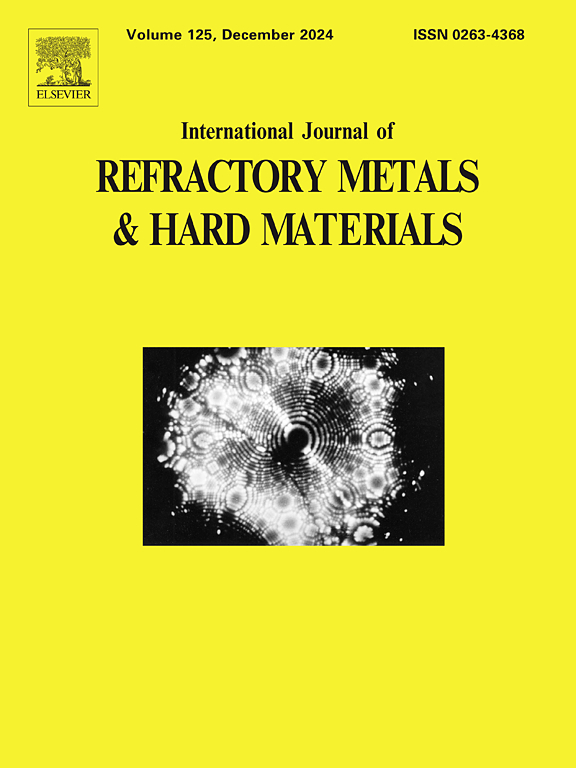掺镍铜锰尖晶石互联保护涂层的加工和性能
IF 4.2
2区 材料科学
Q2 MATERIALS SCIENCE, MULTIDISCIPLINARY
International Journal of Refractory Metals & Hard Materials
Pub Date : 2024-11-02
DOI:10.1016/j.ijrmhm.2024.106947
引用次数: 0
摘要
用于金属支撑固体氧化物燃料电池的不锈钢多孔基底需要保护涂层,以防止阴极铬中毒。本研究采用硝酸甘氨酸燃烧合成工艺合成了 CuNi0.2Mn1.8O4 粉末,并通过电泳沉积法在多孔 SUS 430 基底上沉积了保护涂层,然后采用两步退火法进行了致密化处理。研究发现,500 Hz 的交流信号、±20 V 的电压幅值、60/40 的占空比(涂层沉积与去除时间比)以及 200 RPM 的搅拌速率可在多孔结构的整个表面形成 ∼ 2 μm 的相对均匀的涂层。随着铬掺杂浓度的增加,CuNi0.2Mn1.8O4 的电导率降低,小极子跳跃的活化能增加。经测定,700°C 时铬在 CuNi0.2Mn1.8O4 中的扩散率为 7.93 × 10-20 m2/s。据预测,2 μm 的 CuNi0.2Mn1.8O4 涂层表面即使在运行 50,000 小时后也不会超过铬的溶解极限,这突出表明了该涂层的优异降解特性。建立的模型表明,在 700 °C 下,镀层对面积比电阻的贡献在最初的 250 小时内更为显著,之后,Cr2O3 层的贡献变得更为重要。与未涂覆的样品相比,涂覆金属支架在运行 50,000 小时后的 ASR 预计不到未涂覆样品的 1/10。这些结果表明,AC-EPD CuNi0.2Mn1.8O4 涂层不仅能减轻 SOFC 堆栈中的铬中毒现象,还能保持良好的导电性,从而有望提高电池的长期性能。本文章由计算机程序翻译,如有差异,请以英文原文为准。
Processing and performance of protective Ni-doped CuMn spinel interconnect coatings
Stainless-steel porous substrates for metal-supported solid oxide fuel cells require protective coatings to prevent chromium poisoning of the cathode. In this study, CuNi0.2Mn1.8O4 powders were synthesized by the glycine nitrate combustion synthesis process and protective coatings were deposited on porous SUS 430 substrates by electrophoretic deposition and densified using a two-step annealing procedure. It was found that an AC signal of 500 Hz, 20 V voltage amplitude with a 60/40 duty ratio (coating deposition to removal time ratio), combined with a stirring rate of 200 RPM, resulted in a ∼ 2 μm relatively uniform coating throughout the surfaces of the porous structure. The conductivity of CuNi0.2Mn1.8O4 decreased and the activation energy of small polaron hopping increased with increasing Cr doping concentration. The diffusivity of Cr in CuNi0.2Mn1.8O4 at 700°C was determined to be 7.93 × 10−20 m2/s. It is predicted that the surface of a 2 μm CuNi0.2Mn1.8O4 coating will not exceed the solubility limit of Cr even after 50,000 h of operation, highlighting the excellent gettering property of the coating. A model was developed that indicated that at 700 °C, the coating layer contribution to the area specific resistance is more dominant during the first 250 h, after which the contribution of the Cr2O3 layer becomes more significant. Compared to the uncoated sample, the ASR of the coated metal support is expected to be less than 1/10th of that of an uncoated sample after 50,000 h of operation. These results show that AC-EPD CuNi0.2Mn1.8O4 coatings not only mitigates chromium poisoning in SOFC stacks but also maintains robust electrical conductivity, thereby promising enhanced long-term cell performance.
求助全文
通过发布文献求助,成功后即可免费获取论文全文。
去求助
来源期刊
CiteScore
7.00
自引率
13.90%
发文量
236
审稿时长
35 days
期刊介绍:
The International Journal of Refractory Metals and Hard Materials (IJRMHM) publishes original research articles concerned with all aspects of refractory metals and hard materials. Refractory metals are defined as metals with melting points higher than 1800 °C. These are tungsten, molybdenum, chromium, tantalum, niobium, hafnium, and rhenium, as well as many compounds and alloys based thereupon. Hard materials that are included in the scope of this journal are defined as materials with hardness values higher than 1000 kg/mm2, primarily intended for applications as manufacturing tools or wear resistant components in mechanical systems. Thus they encompass carbides, nitrides and borides of metals, and related compounds. A special focus of this journal is put on the family of hardmetals, which is also known as cemented tungsten carbide, and cermets which are based on titanium carbide and carbonitrides with or without a metal binder. Ceramics and superhard materials including diamond and cubic boron nitride may also be accepted provided the subject material is presented as hard materials as defined above.

 求助内容:
求助内容: 应助结果提醒方式:
应助结果提醒方式:


